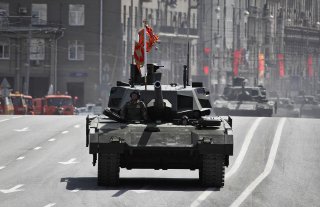The T-14 Armata Tank Could Beat the Abrams - If It Ever Comes Out
When these tanks might be delivered is still very much in question.
Here's What You Need To Remember: The T-14 Armata is a behemoth - but Russia, already cash-strapped before the pandemic, might not be able to afford to pump them out in great numbers.
Despite a reduction in Russian defense spending caused by lower oil prices, which came after the Kremlin opted not to cut production, the Russian military is charging ahead with its Armata combat vehicle program. It is being overseen by Rostec Corporation – the Moscow conglomerate that specializes in consolidating strategically important companies in Russia's defense sector.
This includes the Armata T-14 main battle tanks (MBT) first demonstrated during the May 2015 Victory Parade in Moscow. Sergi Chemezov, Rostec Corporation's chief executive officer, told reporters last week that while any new projects would be discontinued the Armata projects – which include the T-14 as well as the T-15 heavy infantry fighting vehicle and T-16 armored repair and recovery vehicle – were still on track.
However, when these tanks might be delivered is still very much in question.
As of January, the Russian Ground Forces (RGF) had not taken delivery of its first batch of the third-generation T-14s, and delivery has been delayed multiple times around. Delivery was expected on the first nine tanks by Russian tank manufacturer Uralvagonzavod (UVZ) in 2018, before the target date was pushed back to 2019.
The New Russian Tank
Work on the Armata project began in 2010, when the Russian Ministry of Defence terminated work on "Object-195" – the T-95 program. The entire project was seen to be a huge technological leap from Soviet-era military hardware designs and from the ground up the T-14 is very much distinct from past Soviet/Russian tank platforms.
The outline of the tank, from its hull to its long and boxy turret, which resembles Western tank turret designs, is a notable departure from past Soviet designs. The T-14 also features seven road wheels instead of the six wheels that were commonplace on almost all previous Cold War Soviet and even modern Russian MBTs.
It isn't just the profile of the Armata T-14 that sets this tank apart from its predecessors.
Among its innovative characteristics is its unmanned turret, which includes a remotely controlled 125mm 2A82-1M smoothbore main gun with fully automated loading. The turret's magazine contains a total of 45 rounds of ammunition, but the main gun can also fire laser-guide missiles. In addition, the 2A82 125mm gun can even be upgraded to the 2A83 152mm gun, while the T-14 can also be fitted with secondary weapons such as the Kord 12.7mm machine gun or a PKTM 7.62mm machine gun.
The roof of the turret houses a meteorological mast, satellite communications, global navigation satellite system (GLONASS), data-link and radio communications antennae.
More Than Armor
As important to its offensive capabilities is the MBT's ability to keep its crew protected. Here too is where the T-14 excels. This tank features a low-silhouette that reduces exposure to enemy fire, and that enhances the safety and survivability of the three-man crew.
The driver, gunner and tank commander are housed in a crew compartment that is located in an armored capsule at the front portion of the hull, isolated from the automatic loader as well as the ammunition storage in the center of the tank.
The crew compartment is made from composite materials and protected by multilayer armor, which according to analyst reports can withstand a direct hit of nearly any type of round that currently exists including sub-caliber and cumulative rounds. The forward section of the tank is also covered with an active defense system that is designed to intercept anti-tank munitions including sub-caliber rounds such as those from anti-tank guided missiles, rockets and RPGs.
The T-14 is reported to offer up to STANAG 4569 Level 5 protection. The front hemisphere of the tank has reactive armor while the rear is fitted with bar armor that provides additional protections from anti-tank weapons such as an RPG.
One problem all tank crews have faced is that they have a limited view of the world when safely encased within the steel hull of their vehicle, but the T-14's designers have addressed this issue by providing wide-angle cameras fitted around the exterior. These provide a 360 degree all-round vision and situational awareness for the crew, with the commander's sight mounted on the top of the turret also offering an entire field of view while the gunner's sight is fitted with a direct-vision periscope and laser designator. The cameras can be zoomed as necessary, while heat sensing and infrared viewing capabilities are available under all weather conditions, day or night.
Crew comforts are always lacking in an armored vehicle, but the T-14 even features an internal toilet so the crew doesn't need to exit the tank to answer "nature's call."
The T-14 promises to be a formidable foe on the battlefield – at least when it finally rolls into the RGF's arsenals.
Peter Suciu is a Michigan-based freelance writer who has contributed to more than four dozen magazines, newspapers, and website. He is the author of several books on military headgear, including A Gallery of Military Headdress, which is available on Amazon.com. This article first appeared earlier this year.
More From The National Interest:
Russia Has Missing Nuclear Weapons Sitting on the Ocean Floor
How China Could Sink a U.S. Navy Aircraft Carrier
Where World War III Could Start This Year
Image: Wikimedia Commons.

